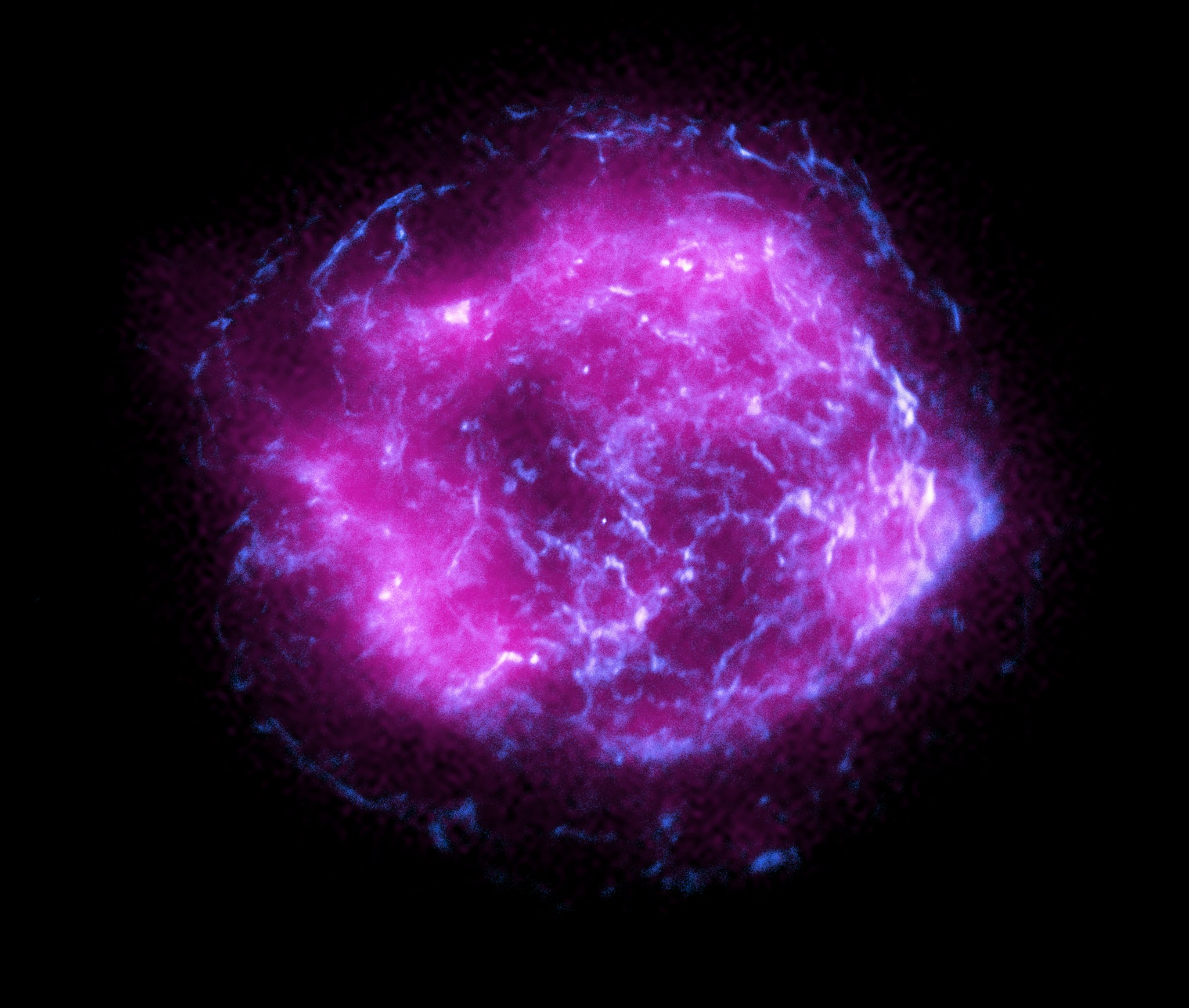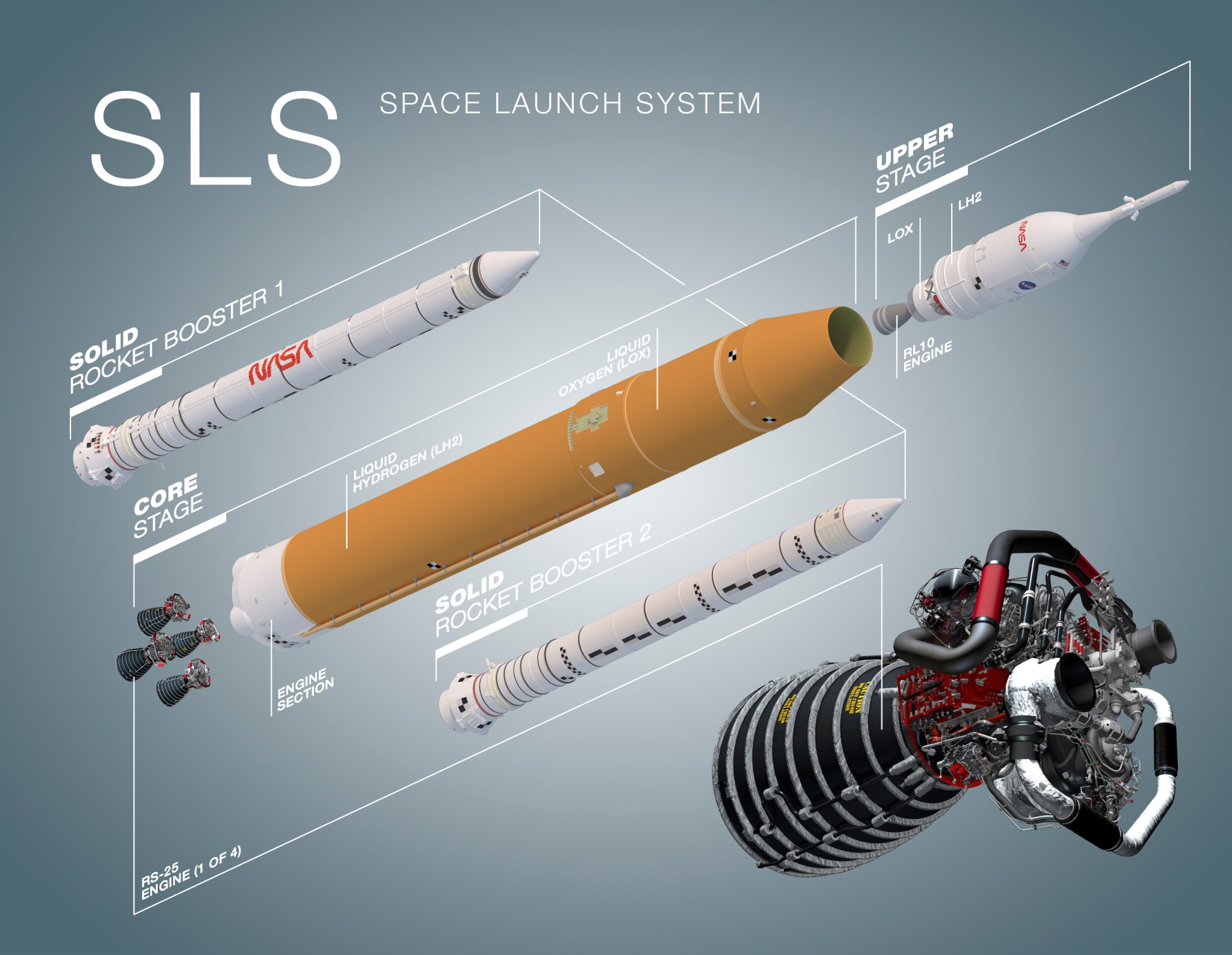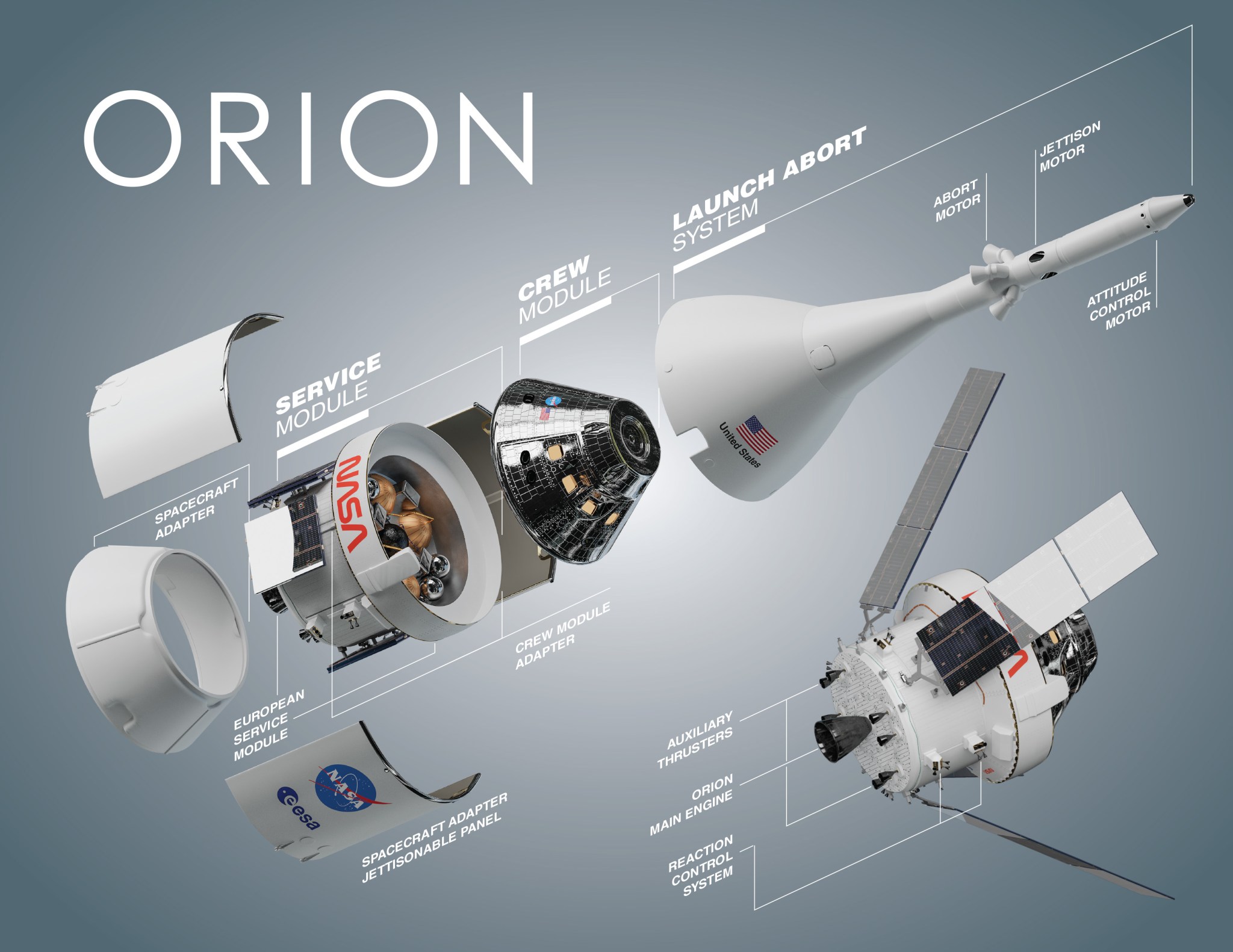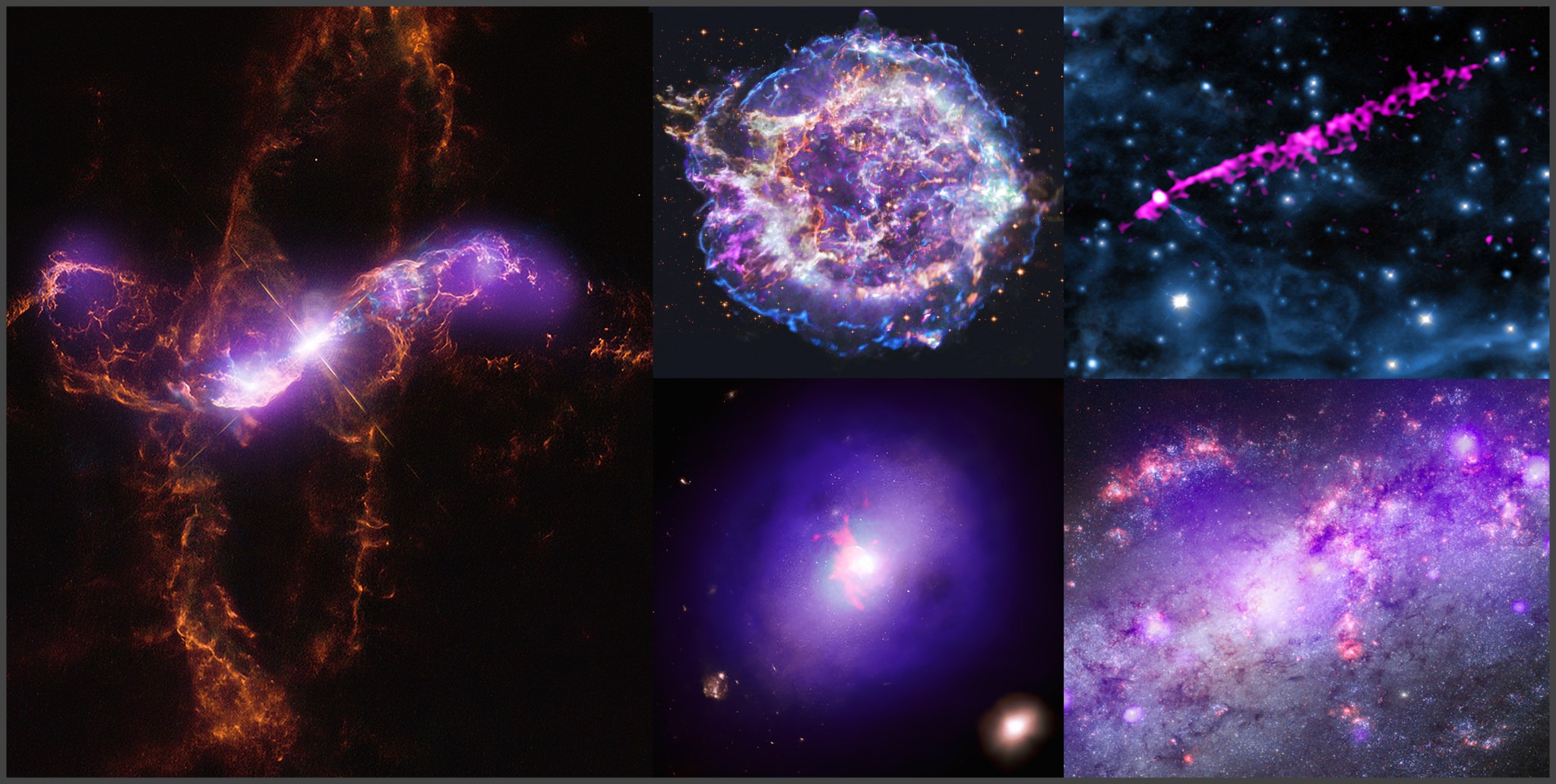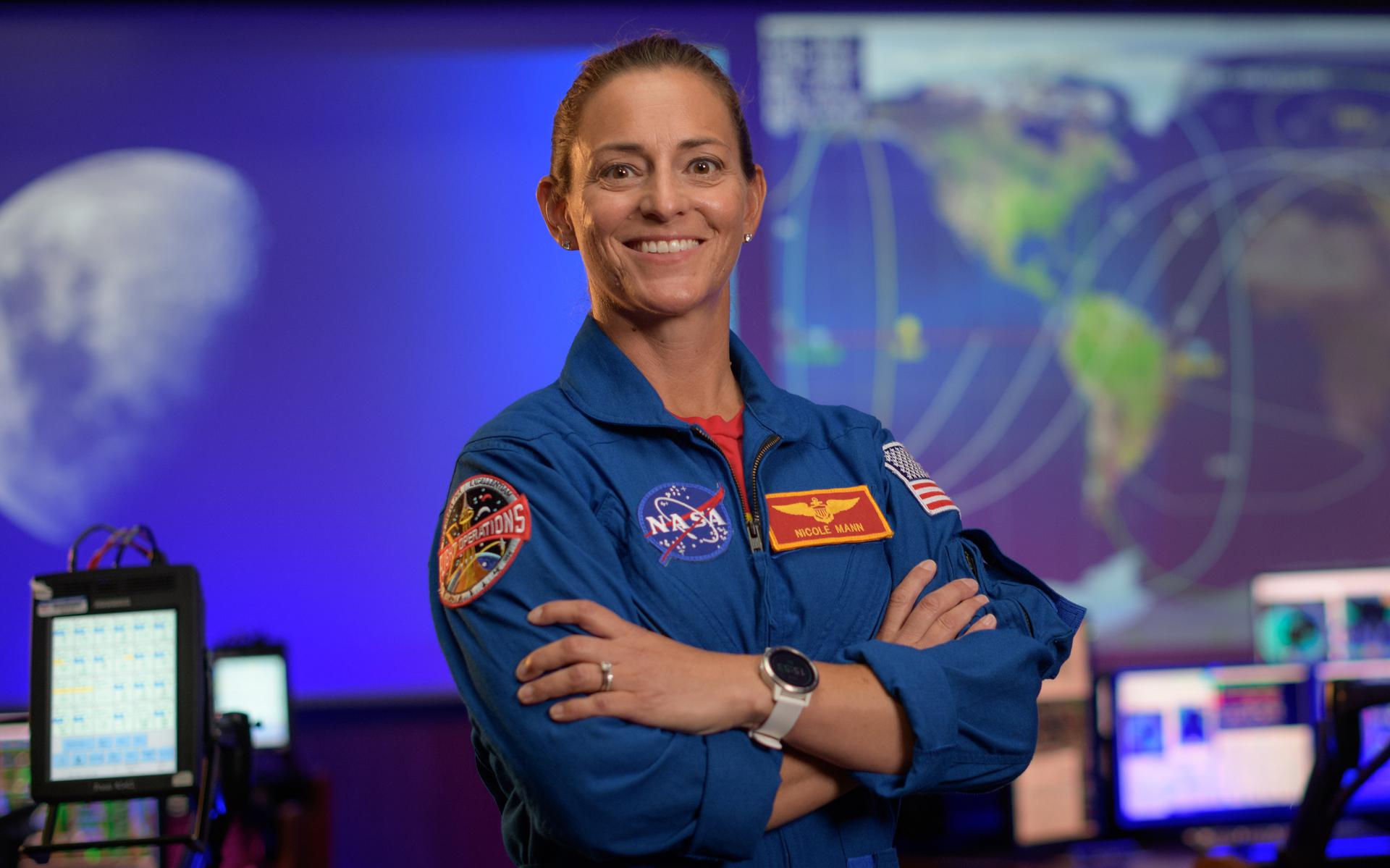NASA’s IXPE Sends First Science Image
In time for Valentine’s Day, NASA’s Imaging X-Ray Polarimetry Explorer, which launched Dec. 9, 2021, has delivered its first imaging data since completing its month-long commissioning phase.
All instruments are functioning well aboard the observatory, which is on a quest to study some of the most mysterious and extreme objects in the universe.
IXPE first focused its X-ray eyes on Cassiopeia A, an object consisting of the remains of a star that exploded in the 17th century. The shock waves from the explosion have swept up surrounding gas, heating it to high temperatures and accelerating cosmic ray particles to make a cloud that glows in X-ray light. Other telescopes have studied Cassiopeia A before, but IXPE will allow researchers to examine it in a new way.
In the new image, the saturation of the magenta color corresponds to the intensity of X-ray light observed by IXPE. It overlays high energy X-ray data, shown in blue, from NASA’s Chandra X-Ray Observatory. Chandra and IXPE, with different kinds of detectors, capture different levels of angular resolution, or sharpness. An additional version of this image is available showing only IXPE data. These images contain IXPE data collected from Jan. 11 to 18.
After Chandra launched in 1999, its first image was also of Cassiopeia A. Chandra’s X-ray imagery revealed, for the first time, that there is a compact object in the center of the supernova remnant, which may be a black hole or neutron star.
“The IXPE image of Cassiopeia A is as historic as the Chandra image of the same supernova remnant,” said Martin Weisskopf, IXPE principal investigator based at NASA’s Marshall Space Flight Center. “It demonstrates IXPE’s potential to gain new, never-before-seen information about Cassiopeia A, which is under analysis right now.”
A key measurement that scientists will make with IXPE is called polarization, a way of looking at how X-ray light is oriented as it travels through space. The polarization of light contains clues to the environment where the light originated. IXPE’s instruments also measure the energy, the time of arrival, and the position in the sky of the X-rays from cosmic sources.
“The IXPE image of Cassiopeia A is bellissima, and we look forward to analyzing the polarimetry data to learn even more about this supernova remnant,” said Paolo Soffitta, Italian principal investigator for IXPE at the National Institute of Astrophysics in Rome.
With polarization data from Cassiopeia A, IXPE will allow scientists to see, for the first time, how the amount of polarization varies across the supernova remnant, which is about 10 light-years in diameter. Researchers are currently working with the data to create the first X-ray polarization map of the object. This will reveal new clues about how X-rays are produced at Cassiopeia A.
“IXPE’s future polarization images should unveil the mechanisms at the heart of this famous cosmic accelerator,” said Roger Romani, an IXPE co-investigator at Stanford University in Palo Alto, California. “To fill in some of those details, we’ve developed a way to make IXPE’s measurements even more precise using machine learning techniques. We’re looking forward to what we’ll find as we analyze all the data.”
IXPE launched on a Falcon 9 rocket from Cape Canaveral, Florida, and now orbits 370 miles above Earth’s equator. The mission is a collaboration between NASA and the Italian Space Agency with partners and science collaborators in 12 countries. Ball Aerospace, headquartered in Broomfield, Colorado, manages spacecraft operations.
Progress on Testing and Instrumentation Installation Ahead of Artemis I Launch
Work continues inside the Vehicle Assembly Building at NASA’s Kennedy Space Center in preparation for the Artemis I wet dress rehearsal test, currently targeted for next month.
Teams have been installing the flight termination system on the rocket and working on the first of a two-part test of the system. For safety, all rockets are required to have a flight termination system that the Space Launch Delta 45 can use to terminate the flight if necessary. Once the rocket and spacecraft systems are verified during wet dress rehearsal testing, the 322-foot-tall rocket will roll back into the Vehicle Assembly Building for final inspections and checkouts, including the second part of the flight termination system test, ahead of returning to the pad for launch.
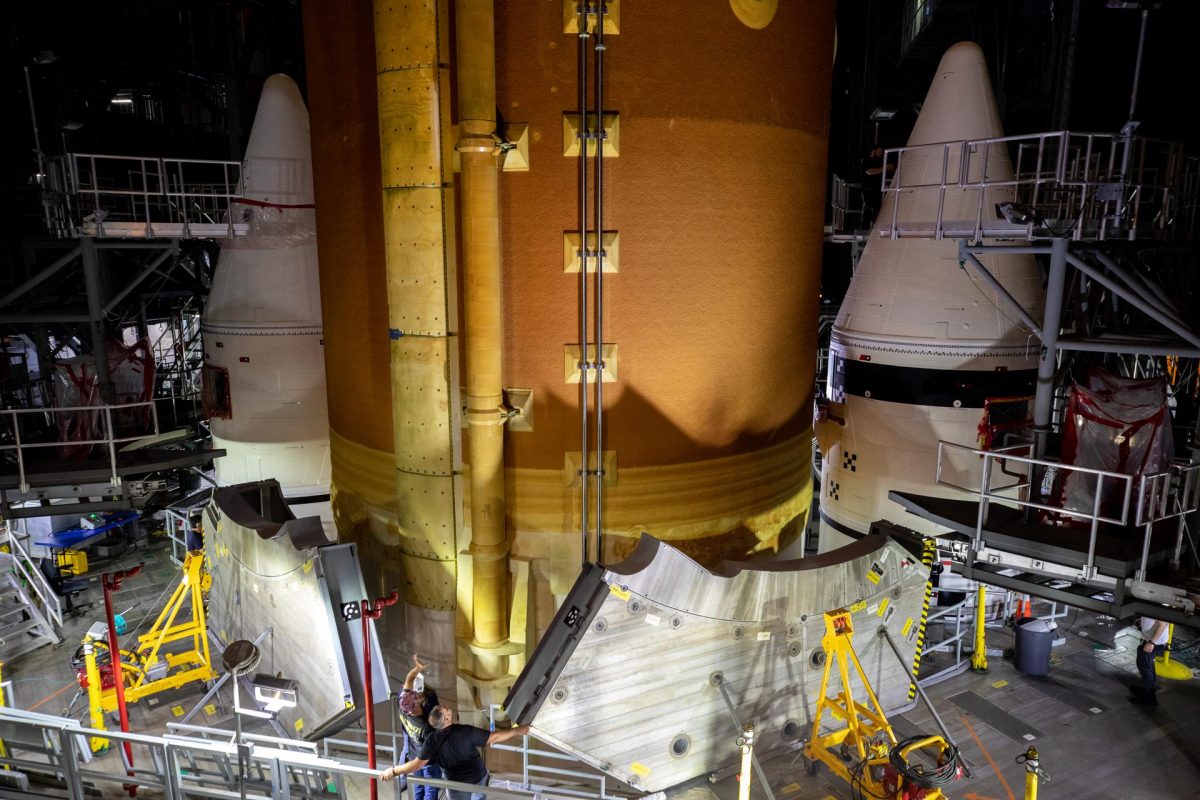
The team is also installing instrumentation on the twin solid rocket boosters and core stage, as well as instrumentation needed for the wet dress rehearsal rollout. Artemis I is a flight test, and engineers will capture as much data as possible on the performance of all the systems that are part of the Space Launch System (SLS) rocket and the Orion spacecraft as well as the Kennedy ground systems that support the vehicle during rollout, wet dress rehearsal, and launch. Not only will this be the first integrated flight for SLS and Orion, but it will be the first use of many new ground systems. Thousands of sensors and special instruments will monitor the rocket and spacecraft as they make the 4-mile journey to Launch Complex 39B next month. The team is also working to inspect and install thermal blankets on the core stage engine section.
Up next, the team plans to power up Orion as part of testing the flight termination system and then close the spacecraft’s hatch after powering it down.
Fired Up: Engines, Motors Put Artemis Mission in Motion
On Earth, many cars on the road are powered by engines that convert fuel into energy to produce motion. Although rocket science is a little more complex, the same basic principle applies to the engines and motors that will help power a journey to the Moon.
On upcoming Artemis missions, the Space Launch System (SLS) rocket and Orion spacecraft will be equipped with several different types of engines and motors. From liftoff to splashdown, these engines and motors will send the first SLS rocket and Orion on the Artemis I mission, out beyond the Moon and farther than any spacecraft built for humans has ever ventured. Missions at the Moon will be a steppingstone to prepare for human exploration of Mars.
On the first Artemis mission, a combined total of 55 engines and motors between the SLS rocket and Orion will propel Orion from the launch pad, around the Moon, and back to Earth. A motor is generally defined as a device that produces motion, and an engine is considered a type of motor that produces motion with the use of moving parts. In rocket science, these terms are typically used to differentiate between rocket motors with solid fuel, that do not employ moving parts to generate thrust, and engines that use moving parts such as pumps and valves to direct liquid fuel through the system. Solid rocket motors may still include moving parts to steer and direct the thrust.
The initial configuration of the SLS rocket, called Block 1, will be used on the first three Artemis missions and stands 322 feet tall, which is taller than the Statue of Liberty. It weighs 5.75 million pounds and produces 8.8 million pounds of thrust during launch and ascent with the power of four RS-25 engines and two solid rocket motors, commonly called boosters. Each booster is equipped with an ignition motor that ignites the solid propellant. About two minutes into flight, the boosters will separate from the rocket and the RS-25 engines on the core stage will continue propelling Orion to orbit. Next, the fairings will be released to expose the service module, and the jettison motor will fire to separate the launch abort system from the spacecraft. The launch abort system is no longer needed at this point, as Orion can safely abort using the engines on the European Service Module, provided by the European Space Agency.
About eight minutes after launch, the RS-25 engines will shut down and the core stage will separate from Orion and the Interim Cryogenic Propulsion Stage (ICPS). The RS-25’s smaller sibling, the RL10 engine, will take over on the ICPS. The RL10 engine will fire for less than one minute to position Orion ahead of a longer burn that will accelerate the spacecraft fast enough to break away from the pull of Earth’s gravity and set a course with a precise trajectory to the Moon. After the RL10 engine has completed the burn to send Orion to the Moon, the ICPS will separate from Orion and the service module will use a combined total of 33 engines to propel and position the spacecraft during the mission until it is time for Orion to reenter Earth’s atmosphere. The service module’s propulsion system can fire for less than a second for spacecraft maneuvering or, in certain emergency situations, the main engine can fire for more than 10 minutes to perform potential abort scenarios.
Just before reentry, the service module will separate from Orion. As Orion prepares to splash down into the Pacific Ocean, the 12 reaction control system engines on the crew module will ensure the spacecraft is properly oriented, with its heat shield pointed downward for entry through Earth’s atmosphere, and stable during descent.
Visit here to learn more about each of the engines and motors that will propel Artemis missions.
Dan Massey Recognized as Space Hero
Dan Massey is the latest team member from NASA’s Marshall Space Flight Center to be named a Space Hero. Massey is the Huntsville Operations Support Center training lead for the Space Launch System Program. His efforts over the past three-plus years have led to the successful execution of the SLS Engineering Support Team standalone and enterprise joint integrated simulations, directly affecting the support team’s readiness to assist in the upcoming Artemis I launch. Each week, the Exploration Systems Development and Space Operations mission directorates recognize Space Heroes, team members from across the agency who have made vital contributions in their support of NASA’s mission to land the first woman and first person of color on the Moon. (NASA)
An Expanse of Light
The recent launches of the James Webb Space Telescope and the Imaging X-ray Polarimetry Explorer by NASA and its international partners are excellent reminders that the universe emits light or energy in many different forms. To fully investigate cosmic objects and phenomena, scientists need telescopes that can detect light across what is known as the electromagnetic spectrum.
The below gallery provides examples of the ways that different types of light from telescopes on the ground and in space can be combined. The common thread in each of these selections is data from NASA’s Chandra X-ray Observatory, illustrating how X-rays – which are emitted by very hot and energetic processes – are found throughout the universe.
R Aquarii: This object is, in fact, a pair: a white dwarf star that steadily burns at a relatively cool temperature and a highly variable red giant. As they orbit each other, the white dwarf pulls material from the red giant onto its surface. Over time, enough of this material accumulates and triggers an explosion. Astronomers have seen such outbursts over recent decades. Evidence for much older outbursts is seen in the spectacular structures observed by NASA’s Hubble Space Telescope (red and blue). X-ray data from Chandra (purple) shows how a jet from the white dwarf is striking material surrounding it and creating shock waves, similar to sonic booms from supersonic planes.
Cassiopeia A: Chandra’s observations of the Cassiopeia A supernova remnant have shown how individual elements from the exploded star are being cast off into space. In this image, X-rays reveal silicon (red), sulfur (yellow), calcium (green), and iron (light purple). The blue around the rim of the remnant reveals the blast wave from the explosion as it travels outward. This image also adds a layer of radio data of Cassiopeia A from the National Science Foundation’s Karl Jansky Very Large Array (dark purple, blue, and white) and an optical image from Hubble (orange). Like X-rays, radio waves can penetrate thick clouds of gas and dust that lie between Earth and Cassiopeia A, providing additional information about this famous stellar explosion.
Guitar Nebula: For the last decade or so, astronomers have been puzzled by the alignment of some jets of X-rays coming from very fast-moving pulsars – that is, spinning neutron stars – that shoot out into interstellar space at odd, unexpected angles. This is what astronomers see with PSR B2224+65, a pulsar found near the structure nicknamed the Guitar Nebula due to its shape in optical light (blue). An X-ray stream (pink) captured by Chandra is pointed nearly perpendicular to the guitar-shaped structure, originating from the magnetic poles of the pulsar.
Abell 2597: Galaxy clusters, the largest structures in the universe held together by gravity, are dynamic environments containing individual galaxies and huge amounts of hot gas and dark matter. Often, an enormous black hole in the center of a cluster can help drive its behavior. In the galaxy cluster Abell 2597, a giant central supermassive black hole is driving the gas outward and creating bubbles, or voids, within it. This composite image of Abell 2597 includes X-rays from Chandra (blue), optical data from the Digitized Sky Survey (orange), and emission from hydrogen atoms in optical light from the Las Campanas Observatory in Chile (red).
NGC 4490: When two galaxies are in the process of merging, the gravitational interaction can trigger waves of star formation. This is the case for NGC 4490, a spiral galaxy that has collided with a smaller galaxy to the upper right but not seen in this image. Scientists think that these two galaxies have already had their closest approach and are now separating from one another. Some of the point-like sources of X-rays represent stellar-mass black holes and neutron stars within the galaxy. In this image of NGC 4490, X-rays from Chandra (purple) have been combined with an optical image from Hubble (red, green, and blue).
NASA’s Marshall Space Flight Center manages the Chandra program. The Smithsonian Astrophysical Observatory’s Chandra X-ray Center controls science operations from Cambridge, Massachusetts, and flight operations from Burlington, Massachusetts.
Read more here.
Astronaut Nicole Mann to Deliver Virtual Talk on Persevering Through Challenges
Astronaut Nicole Mann will give a presentation via Webex at 1 p.m. Feb. 17 as part of the Mission Success is in Our Hands virtual lecture series. In “Longevity in NASA’s Most Dynamic Era Yet,” Mann will share lessons she’s learned about persevering through complex challenges as a team and remaining engaged in the intense, exciting era of human spaceflight NASA is currently traversing. NASA selected Mann as one of eight members of the 21st astronaut class in June 2013. She is currently training for NASA’s SpaceX Crew-5 mission, the fifth rotational mission to the International Space Station aboard the SpaceX Crew Dragon spacecraft. Mann previously trained for the Boeing Starliner mission. She is a former safety and training officer for the T-38 Talon supersonic jet trainer and most recently completed a tour as the assistant to the chief for exploration. Mann led the astronaut corps in the development of the Orion spacecraft, Space Launch System, and Exploration Ground Systems. The California native holds a bachelor’s and a master’s degree in mechanical engineering from the U.S. Naval Academy and Stanford, respectively. Mann is a colonel in the Marine Corps and served as a test pilot in the F/A-18 Hornet and Super Hornet. The goal of Mission Success is in Our Hands is to help team members make meaningful connections between their jobs and the safety and success of NASA and Marshall missions through shared experiences discussions, awards, and recognition. For more information, visit here. (NASA)


























